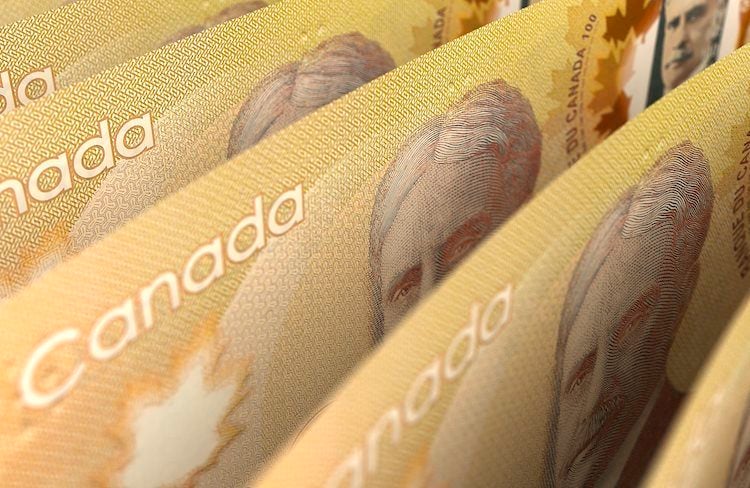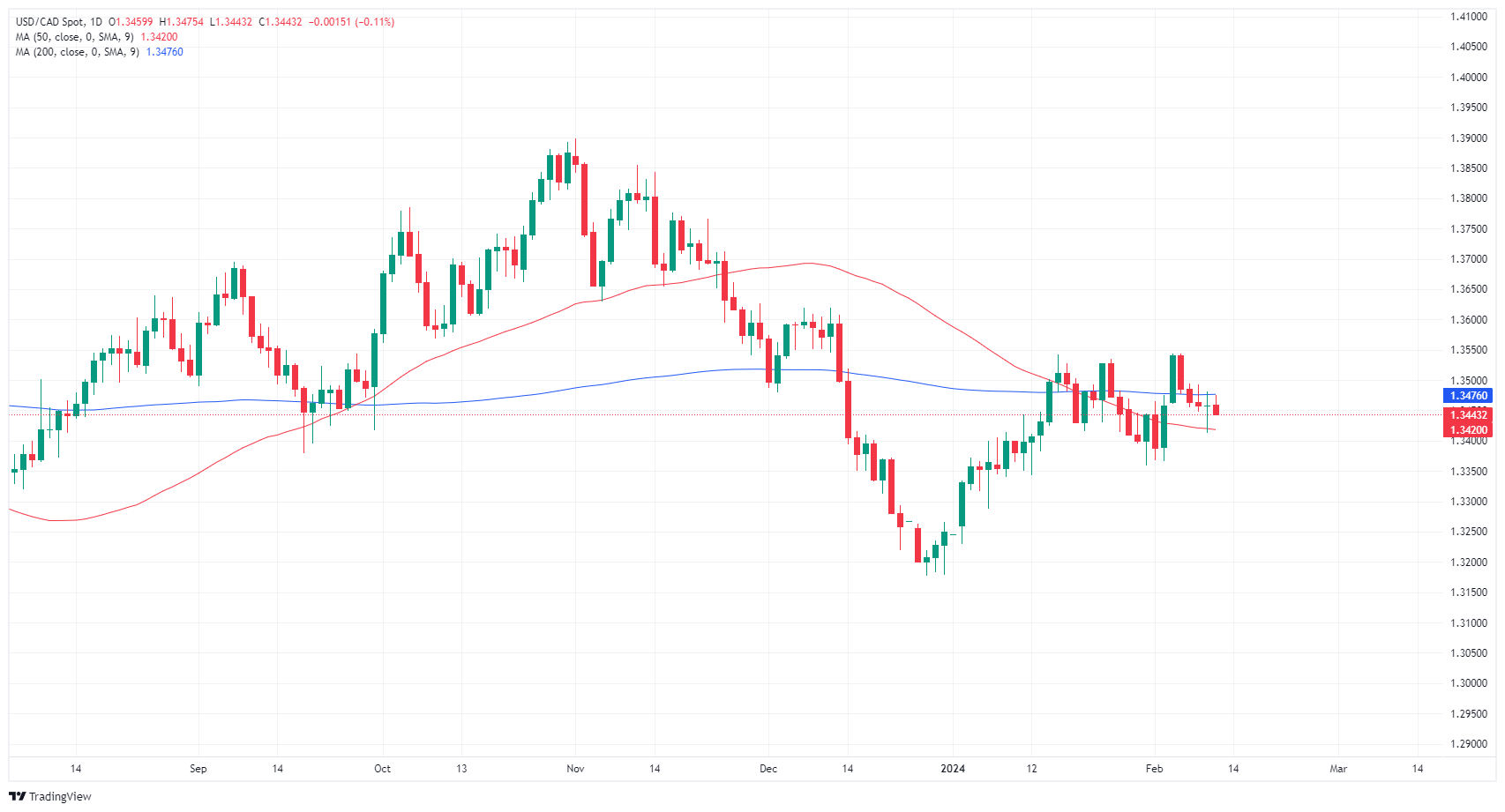Canadian Dollar on the firm side in quiet Monday market action
- Canadian Dollar sees thin gains with support from steady Crude Oil bids.
- Canada sees a data-light economic calendar this week.
- Markets kick off the new trading week on a quiet note ahead of key US inflation data.
The Canadian Dollar (CAD) found some room on the high side on Monday, drifting into the green against most of its major currency peers in thin Monday trading. Markets have opened on a quiet note as investors gear up for a smattering of US economic data, with Tuesday’s US Consumer Price Index (CPI) inflation print a key focus for markets heavily invested in betting on rate cuts from the US Federal Reserve (Fed).
Canada has a light showing on the economic calendar this week, and CAD releases on the data docket are strictly low-impact. Thursday’s Housing Starts are expected to slightly improve, while Friday’s Wholesale Sales are forecast to tick slightly lower. Overall, CAD flows can expect to see Crude Oil markets and US Dollar (USD) risk appetite take the wheel this week.
Daily digest market movers: Canadian Dollar churns in familiar technical territory
- Quiet Monday markets give the Canadian Dollar a chance to recover into the high side, but the CAD remains positioned within familiar chart territory.
- Crude Oil found some support on Monday, helping to bolster the CAD.
- Saudi Arabia’s Energy Minister, Abdulaziz bin Salman Al Saud, stated that the Organization for the Petroleum Exporting Countries (OPEC) remains “ready to tweak oil policy at any time”.
- Fed officials continue to reiterate a more moderate policy stance than markets are hoping for.
- Fed’s Bowman: It is still too soon to project when or how much the Fed will cut rates.
- More Bowman: Many risks still remain for Fed’s inflation fight, doesn’t see cuts as appropriate in the ‘immediate future’.
- The New York Fed’s inflation outlook sees three-year inflation at 2.4% in January, down from December’s three-year outlook of 2.6%.
- According to the CME’s FedWatch Tool, markets are still pricing in nearly 60% odds of a May rate cut.
- Money markets are still holding out hope for six rate cuts through 2024.
Canadian Dollar price today
The table below shows the percentage change of Canadian Dollar (CAD) against listed major currencies today. Canadian Dollar was the strongest against the New Zealand Dollar.
| USD | EUR | GBP | CAD | AUD | JPY | NZD | CHF | |
| USD | 0.24% | 0.10% | -0.12% | -0.13% | 0.18% | 0.24% | 0.17% | |
| EUR | -0.24% | -0.14% | -0.36% | -0.37% | -0.06% | 0.01% | -0.07% | |
| GBP | -0.10% | 0.13% | -0.22% | -0.21% | 0.08% | 0.14% | 0.07% | |
| CAD | 0.13% | 0.35% | 0.21% | -0.02% | 0.30% | 0.37% | 0.29% | |
| AUD | 0.13% | 0.36% | 0.24% | 0.01% | 0.30% | 0.38% | 0.30% | |
| JPY | -0.17% | 0.06% | -0.04% | -0.29% | -0.30% | 0.06% | -0.01% | |
| NZD | -0.25% | 0.00% | -0.15% | -0.37% | -0.38% | -0.06% | -0.07% | |
| CHF | -0.17% | 0.08% | -0.07% | -0.29% | -0.30% | 0.01% | 0.08% |
The heat map shows percentage changes of major currencies against each other. The base currency is picked from the left column, while the quote currency is picked from the top row. For example, if you pick the Euro from the left column and move along the horizontal line to the Japanese Yen, the percentage change displayed in the box will represent EUR (base)/JPY (quote).
Technical analysis: Canadian Dollar sees green in quiet Monday chart action
The Canadian Dollar is broadly higher on Monday, seeing thin gains as markets gear up for another trading week. A quiet Monday has the CAD on the high side for the day, gaining around a third of a percent against the broadly weaker New Zealand Dollar (NZD) and Euro (EUR). The Canadian Dollar is higher against the US Dollar by about a tenth of a percent and close to flat against the Australian Dollar (AUD).
USD/CAD remains pinned below the 1.3500 handle after last week’s decline from the 1.3540 neighborhood, and intraday action continues to cycle the 200-hour Simple Moving Average (SMA) as near-term momentum remains limited.
Daily candlesticks have the USD/CAD trading back into a congestion zone just south of the 200-day SMA near 1.3475 as the 50-day SMA consolidates into the midrange near 1.3420, capping off bearish momentum and squeezing the pair into the middle.
USD/CAD hourly chart
USD/CAD daily chart
Inflation FAQs
Inflation measures the rise in the price of a representative basket of goods and services. Headline inflation is usually expressed as a percentage change on a month-on-month (MoM) and year-on-year (YoY) basis. Core inflation excludes more volatile elements such as food and fuel which can fluctuate because of geopolitical and seasonal factors. Core inflation is the figure economists focus on and is the level targeted by central banks, which are mandated to keep inflation at a manageable level, usually around 2%.
The Consumer Price Index (CPI) measures the change in prices of a basket of goods and services over a period of time. It is usually expressed as a percentage change on a month-on-month (MoM) and year-on-year (YoY) basis. Core CPI is the figure targeted by central banks as it excludes volatile food and fuel inputs. When Core CPI rises above 2% it usually results in higher interest rates and vice versa when it falls below 2%. Since higher interest rates are positive for a currency, higher inflation usually results in a stronger currency. The opposite is true when inflation falls.
Although it may seem counter-intuitive, high inflation in a country pushes up the value of its currency and vice versa for lower inflation. This is because the central bank will normally raise interest rates to combat the higher inflation, which attract more global capital inflows from investors looking for a lucrative place to park their money.
Formerly, Gold was the asset investors turned to in times of high inflation because it preserved its value, and whilst investors will often still buy Gold for its safe-haven properties in times of extreme market turmoil, this is not the case most of the time. This is because when inflation is high, central banks will put up interest rates to combat it.
Higher interest rates are negative for Gold because they increase the opportunity-cost of holding Gold vis-a-vis an interest-bearing asset or placing the money in a cash deposit account. On the flipside, lower inflation tends to be positive for Gold as it brings interest rates down, making the bright metal a more viable investment alternative.





